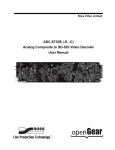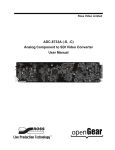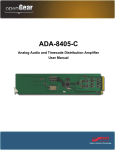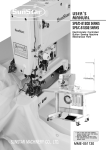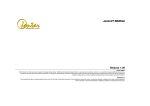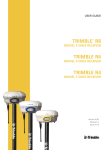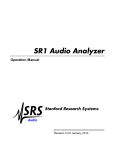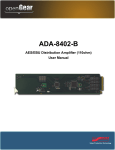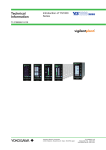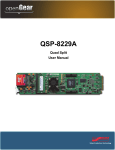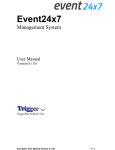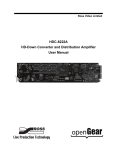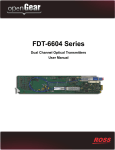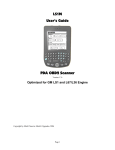Download ADC-8732B Series User Manual
Transcript
ADC-8732B Series Analog Composite to SD-SDI Video Decoder User Manual Thank you for choosing Ross You've made a great choice. We expect you will be very happy with your purchase of Ross Technology. Our mission is to: 1. Provide a Superior Customer Experience • offer the best product quality and support 2. Make Cool Practical Technology • develop great products that customers love Ross has become well known for the Ross Video Code of Ethics. It guides our interactions and empowers our employees. I hope you enjoy reading it below. If anything at all with your Ross experience does not live up to your expectations be sure to reach out to us at [email protected]. David Ross CEO, Ross Video [email protected] Ross Video Code of Ethics Any company is the sum total of the people that make things happen. At Ross, our employees are a special group. Our employees truly care about doing a great job and delivering a high quality customer experience every day. This code of ethics hangs on the wall of all Ross Video locations to guide our behavior: 1. We will always act in our customers’ best interest. 2. We will do our best to understand our customers’ requirements. 3. We will not ship crap. 4. We will be great to work with. 5. We will do something extra for our customers, as an apology, when something big goes wrong and it's our fault. 6. We will keep our promises. 7. We will treat the competition with respect. 8. We will cooperate with and help other friendly companies. 9. We will go above and beyond in times of crisis. If there's no one to authorize the required action in times of company or customer crisis - do what you know in your heart is right. (You may rent helicopters if necessary.) ADC-8732B Series User Manual • Ross Part Number: 8732BDR-004-03 • Release Date: September 29, 2014. Copyright © 2014 Ross Video Limited. Ross®, openGear®, and any related marks are trademarks or registered trademarks of Ross Video Ltd. All other trademarks are the property of their respective companies. PATENTS ISSUED and PENDING. All rights reserved. No part of this publication may be reproduced, stored in a retrieval system, or transmitted in any form or by any means, mechanical, photocopying, recording or otherwise, without the prior written permission of Ross Video. While every precaution has been taken in the preparation of this document, Ross Video assumes no responsibility for errors or omissions. Neither is any liability assumed for damages resulting from the use of the information contained herein. Patents Patent numbers US 7,034,886; US 7,508,455; US 7,602,446; US 7,802,802 B2; US 7,834,886; US 7,914,332; US 8,307,284; US 8,407,374 B2; US 8,499,019 B2; US 8,519,949 B2; US 8,743,292 B2; GB 2,419,119 B; GB 2,447,380 B; and other patents pending. Important Regulatory and Safety Notices to Service Personnel Before using this product and nay associated equipment, refer to the “Important Safety Instructions” listed below to avoid personnel injury and to prevent product damage. Product may require specific equipment, and/or installation procedures to be carried out to satisfy certain regulatory compliance requirements. Notices have been included in this publication to call attention to these specific requirements. Symbol Meanings This symbol on the equipment refers you to important operating and maintenance (servicing) instructions within the Product Manual Documentation. Failure to heed this information may present a major risk of damage to persons or equipment. Warning — The symbol with the word “Warning” within the equipment manual indicates a potentially hazardous situation, which, if not avoided, could result in death or serious injury. Caution — The symbol with the word “Caution” within the equipment manual indicates a potentially hazardous situation, which, if not avoided, may result in minor or moderate injury. It may also be used to alert against unsafe practices. Notice — The symbol with the word “Notice” within the equipment manual indicates a potentially hazardous situation, which, if not avoided, may result in major or minor equipment damage or a situation which could place the equipment in a non-compliant operating state. ESD Susceptibility — This symbol is used to alert the user that an electrical or electronic device or assembly is susceptible to damage from an ESD event. Important Safety Instructions Caution — This product is intended to be a component product of the DFR-8300 series and OG3-FR series frame. Refer to the DFR-8300 and OG3-Fr Series Frame User Manual for important safety instructions regarding the proper installation and safe operation of the frame as well as its component products. Warning — Certain parts of this equipment namely the power supply area still present a safety hazard, with the power switch in the OFF position. To avoid electrical shock, disconnect all A/C power cords from the chassis’ rear appliance connectors before servicing this area. Warning — Service barriers within this product are intended to protect the operator and service personnel from hazardous voltages. For continued safety, replace all barriers after any servicing. This product contains safety critical parts, which if incorrectly replaced may present a risk of fire or electrical shock. Components contained with the product’s power supplies and power supply area, are not intended to be customer serviced and should be returned to the factory for repair. To reduce the risk of fire, replacement fuses must be the same time and rating. Only use attachments/accessories specified by the manufacturer. EMC Notices United States of America FCC Part 15 This equipment has been tested and found to comply with the limits for a class A Digital device, pursuant to part 15 of the FCC Rules. These limits are designed to provide reasonable protection against harmful interference when the equipment is operated in a commercial environment. This equipment generates, uses, and can radiate radio frequency energy and, if not installed and used in accordance with the instruction manual, may cause harmful interference to radio communications. Operation of this equipment in a residential area is likely to cause harmful interference in which case the user will be required to correct the interference at their own expense. Notice — Changes or modifications to this equipment not expressly approved by Ross Video Limited could void the user’s authority to operate this equipment. CANADA This Class “A” digital apparatus complies with Canadian ICES-003. Cet appariel numerique de la classe “A” est conforme a la norme NMB-003 du Canada. EUROPE This equipment is in compliance with the essential requirements and other relevant provisions of CE Directive 93/68/EEC. INTERNATIONAL This equipment has been tested to CISPR 22:1997 along with amendments A1:2000 and A2:2002, and found to comply with the limits for a Class A Digital device. Notice — This is a Class A product. In domestic environments, this product may cause radio interference, in which case the user may have to take adequate measures. Maintenance/User Serviceable Parts Routine maintenance to this openGear product is not required. This product contains no user serviceable parts. If the module does not appear to be working properly, please contact Technical Support using the numbers listed under the “Contact Us” section on the last page of this manual. All openGear products are covered by a generous 5-year warranty and will be repaired without charge for materials or labor within this period. See the “Warranty and Repair Policy” section in this manual for details. Environmental Information The equipment that you purchased required the extraction and use of natural resources for its production. It may contain hazardous substances that could impact health and the environment. To avoid the potential release of those substances into the environment and to diminish the need for the extraction of natural resources, Ross Video encourages you to use the appropriate take-back systems. These systems will reuse or recycle most of the materials from your end-of-life equipment in an environmentally friendly and health conscious manner. The crossed out wheelie bin symbol invites you to use these systems. If you need more information on the collection, re-use, and recycling systems, please contact your local or regional waste administration. You can also contact Ross Video for more information on the environmental performance of our products. Company Address Ross Video Limited Ross Video Incorporated 8 John Street P.O. Box 880 Iroquois, Ontario, K0E 1K0 Ogdensburg, New York Canada USA 13669-0880 General Business Office: (+1) 613 • 652 • 4886 Fax: (+1) 613 • 652 • 4425 Technical Support: (+1) 613 • 652 • 4886 After Hours Emergency: (+1) 613 • 349 • 0006 E-mail (Technical Support): [email protected] E-mail (General Information): [email protected] Website: http://www.rossvideo.com Contents Introduction 1 Overview.............................................................................................................................. 1-2 Features.................................................................................................................. 1-3 Functional Block Diagram................................................................................................... 1-4 User Interfaces ..................................................................................................................... 1-5 DashBoard Control System ................................................................................... 1-5 Card-edge Monitoring ........................................................................................... 1-5 SNMP Monitoring and Control ............................................................................. 1-5 Documentation Terms and Conventions.............................................................................. 1-6 Installation 2 Before You Begin ................................................................................................................ 2-2 Static Discharge..................................................................................................... 2-2 Unpacking.............................................................................................................. 2-2 Installing the ADC-8732B Series ........................................................................................ 2-3 Supported Rear Modules ....................................................................................... 2-3 Installing a Rear Module ....................................................................................... 2-4 Installing the Card ................................................................................................. 2-5 Cabling Overview ................................................................................................................ 2-6 Cabling for the ADC-8732B and ADC-8732B-S.................................................. 2-6 Cabling for the ADC-8732B-C and ADC-8732B-SC ........................................... 2-6 Video Cabling....................................................................................................... 2-7 Audio Cabling ....................................................................................................... 2-7 Software Upgrades............................................................................................................... 2-9 Installing a License Key ........................................................................................ 2-9 Performing Software Upgrades ............................................................................. 2-9 User Controls 3 Card Overview ..................................................................................................................... 3-2 Tracking Pulse Output........................................................................................... 3-3 Control and Monitoring Features......................................................................................... 3-4 Status and Selection LEDs .................................................................................... 3-4 Notes on Timing Modes ...................................................................................................... 3-6 Line Delay Mode................................................................................................... 3-6 Line Sync Mode .................................................................................................... 3-6 Frame Delay Mode ................................................................................................ 3-7 Frame Sync Mode.................................................................................................. 3-7 DashBoard Menus 4 Status Tabs ........................................................................................................................... 4-2 Product Tab ........................................................................................................... 4-2 Hardware Tab ........................................................................................................ 4-2 Signal Tab.............................................................................................................. 4-3 Setup Tab ............................................................................................................................. 4-4 ADC-8732B Series User Manual (Iss. 03) Contents • i Timing Tab........................................................................................................................... 4-5 Output Tab ........................................................................................................................... 4-6 Framing Tab ......................................................................................................................... 4-7 Proc Amp Tab ...................................................................................................................... 4-8 Audio Tab............................................................................................................................. 4-9 Alarms Tab......................................................................................................................... 4-10 Heads-up Display 5 HUD Overview .................................................................................................................... 5-2 Navigation.............................................................................................................. 5-2 Bank A Menus...................................................................................................................... 5-3 Bank A Menu Parameters ...................................................................................... 5-4 Bank B Menus...................................................................................................................... 5-6 Bank B Menu Parameters ...................................................................................... 5-6 Bank C Menus...................................................................................................................... 5-8 Bank C Menu Parameters ...................................................................................... 5-9 Bank D Menus.................................................................................................................... 5-11 Bank D Menu Parameters .................................................................................... 5-12 Specifications 6 Technical Specifications ...................................................................................................... 6-2 Service Information 7 Troubleshooting Checklist ................................................................................................... 7-2 Bootload Button..................................................................................................... 7-2 Warranty and Repair Policy ................................................................................................. 7-3 ii • Contents ADC-8732B Series User Manual (Iss. 03) Introduction In This Chapter This chapter contains the following sections: • Overview • Functional Block Diagram • User Interfaces • Documentation Terms and Conventions A Word of Thanks Congratulations on choosing an openGear ADC-8732B Series Analog Composite to SD-SDI Video Decoder. Your ADC-8732B series card is part of a full line of products within the openGear Terminal Equipment family of products, backed by Ross Video’s experience in engineering and design expertise since 1974. You will be pleased at how easily your new card fits into your overall working environment. Equally pleasing is the product quality, reliability and functionality. Thank you for joining the group of worldwide satisfied Ross Video customers! Should you have a question pertaining to the installation or operation of your card, please contact us at the numbers listed on the back cover of this manual. Our technical support staff is always available for consultation, training, or service. ADC-8732B Series User Manual (Iss. 03) Introduction • 1–1 Overview The ADC-8732B series is a 10bit broadcast quality video decoder with a 12bit analog to digital converter. It is specifically designed for broadcast or production situations in which an analog PAL-B, PAL-M, PAL-N, or NTSC composite signal must be converted to a component SD-SDI signal. Seven SD-SDI outputs are provided. The ADC-8732B series fits into the openGear frames. Refer to the DFR-8300 Series or OG3-FR Series Frames User Manual for specific ventilation and cooling instructions to maintain optimum operating conditions. The ADC-8732B series is available in the following models: • ADC-8732B — The base model decoder includes Proc Amps, Line Delay, and Line Synchronizer modes. • ADC-8732B-S — This model includes a Frame Synchronizer, along with all the features available on the ADC-8732B. • ADC-8732B-C — This model includes the AAM-8581 daughter card and includes four channels of analog audio embedding along with all the features available on the ADC-8732B. • ADC-8732B-SC — This model includes a Frame Synchronizer in addition to all the features available on the ADC-8732B-C and the ADC-8732B. The complete circuit for the ADC-8732B, including a 12bit A-D converter, decoder, Line (or frame) synchronizer, serializer, tracking delay pulse, and microprocessor is contained on a single DA-sized card. Additional daughter cards are required for audio embedding. A 10bit decoding process provides excellent performance with all types of picture sources. The decoder uses 3-line, 5-line, and adaptive 3D filters with advanced control algorithms. To simplify configuration, the ADC-8732B series offers two methods: • DashBoard Control System — The ADC-8732B series is fully compliant with all openGear technical specifications and supports remote monitoring and control via the DashBoard Control System. • Heads-up Display (HUD) — The ADC-8732B series includes an on-screen display that enables you to view adjustments made using the card-edge controls. • Changes made using either of the above methods are reflected in the other. ADC-8732B-S Overview The ADC-8732B-S models comes with a full featured frame sychronizer, capable of synchronizing incoming video to house reference. Various timing modes are available to accommodate most situations. ADC-8732B-C Overview The ADC-8732B-C models includes the ADC-8732B or the ADC-8732B-S, the AAM-8581, and the appropriate rear module. The AAM-8581 is a daughter card that plugs onto the top of the ADC-8732B board and enables you to add four channels of analog audio conversion and embedding to the SDI video output of the ADC-8732B series card. The AAM-8581 uses state of the art analog to digital converters that provide 24bit resolution. The audio gain adjustment is provided in the analog domain through the use of digital potentiometers and has a range of ±10dBu. 1–2 • Introduction ADC-8732B Series User Manual (Iss. 03) Features The following features make the ADC-8732B series the most flexible, high-quality decoding card for your analog to digital conversion requirements: • 12bit analog to digital conversion • 10bit decoding with 3-line/5-line/3D adaptive comb filters • Optional Frame Synchronization (no daughter card required) • Freeze modes • Horizontal and vertical timing adjustments • Programmable vertical interval blanking • Setup adjustment • Black level offset • Passes Super Black • Status indicator LEDs on card-edge • Choice of reference inputs (composite sync only) • Tracking Delay output for companion audio synchronizer • Built-in test signals • Reports status and configuration remotely via the DashBoard Control System • Fits openGear frames • Fully compliant with openGear specifications • 5-year transferable warranty ADC-8732B-C Features The following features are also available for the ADC-8732B-C: • 4 channel audio embedding • 24bit ADC resolution • Selectable maximum input level from -10dBu to +10dBu in 0.5dBu increments • +/- 0.05dB frequency response 20Hz to 22Hz • Audio Clip LED on card-edge • Alarm feature via DashBoard • Silence alarm with threshold and alarm timeout settings • Audio Delay up to 5 seconds ADC-8732B Series User Manual (Iss. 03) Introduction • 1–3 Functional Block Diagram This section provides a functional block diagram that outlines the workflow of the ADC-8732B series card. ** ** ** ** ** * Available on the ADC-8732B-S and ADC-8732B-SC only ** Not available when using a Split Rear Module Figure 1.1 ADC-8732B — Simplified Block Diagram 1–4 • Introduction ADC-8732B Series User Manual (Iss. 03) User Interfaces The following interfaces are available for control and monitoring of your card. DashBoard Control System DashBoard enables you to monitor and control openGear frames and cards from a computer. DashBoard communicates with other cards in the openGear frame through the Network Controller card. For More Information on... • the menus in DashBoard, refer to the section “DashBoard Menus” on page 4-1. • installing and using DashBoard, refer to the DashBoard User Manual. Card-edge Monitoring The card-edge includes jumpers for selecting the input video standard, navigating the HUD menus, configuring the Tracking Pulse output, and terminating the reference signal on the rear module. LEDs are available for monitoring the status of the signals. For More Information on... • the jumpers available on the card-edge, refer to the section “Card Overview” on page 3-2. • the card-edge LEDs, refer to the section “Control and Monitoring Features” on page 3-4. SNMP Monitoring and Control The Network Controller card in the openGear frame provides optional support for remote monitoring and control of your frame and openGear cards using Simple Network Management Protocol (SNMP), which is compatible with many third-party monitoring and control tools. For More Information on... • SNMP controls on your card, refer to your ADC-8732B Management Information Base (MIB) file. • SNMP Monitoring and Control, refer to your MFC-8300 Series or MFC-OG3 Series User Manual. ADC-8732B Series User Manual (Iss. 03) Introduction • 1–5 Documentation Terms and Conventions The following terms and conventions are used throughout this manual. Terms The following terms are used: • “525-line mode” refers to broadcast situations using NTSC or PAL-M composite (analog) signal reference inputs. • “625-line mode” refers to broadcast situations using PAL-B or PAL-N composite (analog) signal reference inputs. • “ADC-8732B series” refers to all versions of the card unless otherwise indicated. • “Board”, and “Card” refer to the ADC-8732B series within openGear frames, including all components and switches. • “Frame” refers to openGear frame that houses the ADC-8732B series card. • “HUD” refers to the Heads-up Display feature of the card. • “openGear frame” also includes all version of the DFR-8300 and OG3-FR series frames and any available options unless otherwise noted. • “Operator” and “User” refer to the person who uses ADC-8732B series card • “PAL” refers to PAL-B, PAL-M, and PAL-N unless otherwise stated. • “System” and “Video system” refer to the mix of interconnected production and terminal equipment in your environment. Conventions The following conventions are used: • 1–6 • Introduction The “Operating Tips” and “Note” boxes are used throughout this manual to provide additional user information. ADC-8732B Series User Manual (Iss. 03) Installation In This Chapter This chapter provides instructions for installing the Rear Module(s) for the ADC-8732B series installing the card into the frame, cabling details, and upgrading the card software. The following topics are discussed: • Before You Begin • Installing the ADC-8732B Series • Cabling Overview • Software Upgrades ADC-8732B Series User Manual (Iss. 03) Installation • 2–1 Before You Begin Before proceeding with the instructions in this chapter, ensure that your openGear frame is properly installed according to the instructions in its manual. Static Discharge Throughout this chapter, please heed the following cautionary note: ESD Susceptibility — Static discharge can cause serious damage to sensitive semiconductor devices. Avoid handling circuit boards in high static environments such as carpeted areas and when synthetic fiber clothing is worn. Always exercise proper grounding precautions when working on circuit boards and related equipment. Unpacking Unpack each card you received from the shipping container and ensure that all items are included. If any items are missing or damaged, contact your sales representative or Ross Video directly. 2–2 • Installation ADC-8732B Series User Manual (Iss. 03) Installing the ADC-8732B Series This section outlines how to install a Rear Module in an openGear frame. The same procedure applies regardless of the frame or card type. However, the specific Rear Module you need to install depends on the card model and frame you are using. Note — An error message displays in the DashBoard Hardware Status field when using the AAM-8581 daughter card with an unsupported Rear Module. The following Rear Modules are not supported by the AAM-8581: 8310AR-030, 8310AR-031, 8320AR-030, 8320AR-031, 8320AR-040, and 8320AR-041. Supported Rear Modules This section outlines the supported rear modules for each card model. Rear Modules for the ADC-8732B The ADC-8732B supports the following rear modules: • DFR-8310 series frames — The 8310AR-030 Rear Module is required. The ADC-8732B is also compatible with the DFR-8310-BNC frame. • DFR-8321 series and OG3-FR series frames — The 8320AR-030 Full Rear Module or the 8320AR-031 Split Rear Module can be used. Rear Modules for the ADC-8732B-S The ADC-8732B-S supports the following rear modules: • DFR-8310 series frames — The 8310AR-030 Rear Module is required. The ADC-8732B is also compatible with the DFR-8310-BNC frame. • DFR-8321 series and OG3-FR series frames — The 8320AR-030 Full Rear Module or the 8320AR-031 Split Rear Module can be used. Rear Modules for the ADC-8732B-C The ADC-8732B-C supports the following rear modules: • DFR-8310 series frames — The 8310AR-037 Rear Module is required. The ADC-8732B-C is not compatible with the DFR-8310-BNC frame. • DFR-8321 series and OG3-FR series frames — The 8320AR-037 Full Rear Module is required. Rear Modules for the ADC-8732B-SC The ADC-8732B-SC supports the following rear modules: • DFR-8310 series frames — The 8310AR-037 Rear Module is required. The ADC-8732B-SC is not compatible with the DFR-8310-BNC frame. • DFR-8321 series and OG3-FR series frames — The 8320AR-037 Full Rear Module is required. ADC-8732B Series User Manual (Iss. 03) Installation • 2–3 Installing a Rear Module If you are installing the card in a DFR-8310-BNC frame, or the Rear Module is already installed, proceed to the section “Installing the Card” on page 2-5. Note — Do not install the ADC-8732B-C or the ADC-8732B-SC in slot 10 of your DFR-8310 series frame when using an MFC-8310-N series Network Controller Card. Doing so may damage the Network Controller Card, the AAM-8581, or both. To install a rear module in your openGear frame 1. Refer to the DFR-8300 and OG3-FR Series User Manual to ensure that the frame is properly installed. 2. On the rear of the frame, locate the card frame slot. 3. Remove the Blank Plate from the rear of the slot you have chosen for card installation. 4. As shown in Figure 2.1, seat the bottom of the rear module in the seating slot at the base of the frame’s back plane. Screw Hole Module Seating Slots Figure 2.1 Rear Module Installation in an openGear Frame (Card not shown) 5. Align the top hole of the rear module with the screw hole on the top edge of the frame back plane. 6. Using a Phillips screwdriver and the supplied screw, fasten the rear module to the back plane. Do not over-tighten. 7. Verify whether your Rear Module Label is self-adhesive by checking the back of the label for a thin wax sheet. You must remove the wax sheet before affixing the label. 8. Affix the supplied Rear Module Label to the BNC area of the Rear Module. 9. Ensure proper frame cooling and ventilation by having all rear frame slots covered with rear modules or blank metal plates. 2–4 • Installation ADC-8732B Series User Manual (Iss. 03) Installing the Card If the card is to be installed in any compatible frame other than a Ross Video product, refer to the frame manufacturer’s manual for specific instructions. Notice — Heat and power distribution requirements within a frame may dictate specific slot placements of cards. Cards with many heat-producing components should be arranged to avoid areas of excess heat build-up, particularly in frames using convectional cooling. To install the card in the openGear frame 1. Locate the Rear Module you installed in the procedure “Installing a Rear Module” on page 2-4. 2. Hold the card by the edges and carefully align the card-edges with the slots in the frame. 3. Fully insert the card into the frame until the rear connection plus is properly seated in the Rear Module. ADC-8732B Series User Manual (Iss. 03) Installation • 2–5 Cabling Overview This section provides information for connecting cables to the installed Rear Modules on the openGear frames. Connect the input and output cables according to the following sections. Cabling for the ADC-8732B and ADC-8732B-S The ADC-8732B and ADC-8732B-S are used with the following Rear Modules: • 8310AR-030 Rear Module — Each rear module occupies one slot and accommodates one card. This rear module provides seven SD-SDI outputs, one tracking pulse output, and a reference input. (Figure 2.2) • 8320AR-030 Full Rear Module — Each rear module occupies two slots and accommodates one card. This rear module provides seven SD-SDI outputs, one tracking pulse output, and a reference input. (Figure 2.2) • 8320AR-031 Split Rear Module — Each rear module occupies two slots and accommodates two cards. This rear module provides two or three outputs per card. (Figure 2.3) Figure 2.2 Cable Connections for the 8310AR-030 and 8320AR-030 Figure 2.3 Cable Connections for the 8320AR-031 Cabling for the ADC-8732B-C and ADC-8732B-SC The ADC-8732B-C and ADC-8732B-SC are used with the following Rear Modules: 2–6 • Installation • 8310AR-037 Rear Module — Each rear module occupies one slot and accommodates one card. This rear module provides four audio inputs, three SDI outputs, one tracking pulse output, and a reference output. (Figure 2.4) • 8320AR-037 Full Rear Module — Each rear module occupies two slots and accommodates one card. This rear module provides four audio inputs, three SDI outputs, one tracking pulse output, and a reference output. (Figure 2.4) ADC-8732B Series User Manual (Iss. 03) Figure 2.4 Cable Connections for the 8310AR-037 and 8320AR-037 Video Cabling Use the following procedure to cable the card: 1. Connect the input composite signal to BNC 1 (CVBS In). If you are using the 8320AR-031 Split Rear Module, BNC 1 or BNC 2 can be used, depending on the positioning of the card in the frame. 2. Connect downstream SD-SDI devices to BNCs 2 through 6, 8, and 10 (SD-SDI Out). If you are using the 8320AR-031 Split Rear Module, connect to the required BNCs as indicated in Figure 2.3. 3. Connect BNC 7 (TRK Pulse Out) to any device that needs to track the video delay through the ADC-8732B or ADC-8732B-S. • The Tracking Pulse is a positive 5V pulse. Its width tracks the video delay as it passes through the card. The ADC-8732B tracking delay pulse tracks up to two video lines, the ADC-8732B-S up to two fields. • If you are using the 8320AR-031 Split Rear Module, connect to BNC 8 to JP3 is set to the default. 4. Connect a video reference in one of two ways: • Connect to BNC 9 (Reference) on the Rear Module. If you are using the 8320AR-031 Split Rear Module, connect to BNC 9 or BNC 10, depending on the positioning of the card in the frame; or • Connect to REF1 or REF2 on the back of the frame. 5. Specify the reference source using DashBoard or the Heads-Up Display. Audio Cabling The 8310AR-037 and 8320AR-037 Rear Modules provide four audio terminal blocks with removable connectors for Audio In 1, 2, 3, and 4 (refer to Figure 2.4 for cable designations). Note that each connector has locations for the positive, negative, and grounded wires of a balanced analog audio cable. ADC-8732B Series User Manual (Iss. 03) Installation • 2–7 To wire the analog audio 1. Insert an analog audio wire to the designated polarity slot on the connector of the rear module. Figure 2.5 Connector Side View Connector Top Views Connector Connector End View Polarity Indications Tie Wrap (without cable) Audio Cable Figure 2.5 Connector Wiring for 8310AR-037 and 8320AR-037 Input Sockets 2. Use a tweaker screwdriver to tighten the corresponding capture screw. 3. Repeat steps 1 and 2 for each wire on each connector. 4. Once the cables are wired to the connectors, install the connectors on the terminal blocks for the rear module. 2–8 • Installation ADC-8732B Series User Manual (Iss. 03) Software Upgrades This section provides instructions for installing a license key and upgrading the software for your card using DashBoard. Installing a License Key When installing a license key on the card: • You must have DashBoard installed and communicating with the openGear frame that houses the card you wish to install the key for. The DashBoard software and manual are available from the Ross Video website. • Ensure that you are using version 2.0 or higher of DashBoard. This information is available by selecting Help > About DashBoard from the DashBoard main toolbar. To install a license key 1. Launch the DashBoard client on your computer. 2. In DashBoard, display the Device tab of the card by double-clicking its status indicator in the Basic Tree View. 3. Select the Setup tab in the Device View to display the setup information. 4. Make a note of the Request Code in the License Key field. 5. Contact Ross Video Technical Support using the information found in the section “Contact Us”. • When you speak to the Technical Support representative, tell them your name, your facility name, and the Request Code from the Setup tab from step 4. • You will be given a License Key that must be entered in the License field of the Setup tab. 6. Enter the License Key in the License box of the Setup tab. 7. When the installation is complete, verify that the following has occurred: • the Setup tab displays “Licensed” in the Frame Sync field. • the Frame Sync field displays a green background. Performing Software Upgrades DashBoard enables you to upload software updates to the card. To upgrade the software 1. Contact Ross Technical Support for the latest software version file. 2. In DashBoard, display the Device tab of the card by double-clicking its status indicator in the Basic Tree View. 3. From the Device tab, click Upload to display the Select File for upload dialog box. 4. Click Browse... to navigate to the *.bin file you wish to upload. DashBoard automatically selects the last directory that you loaded from. 5. Click Open to display a confirmation dialog. This dialog displays the selected upload file name, type, size, and the file creation date. ADC-8732B Series User Manual (Iss. 03) Installation • 2–9 6. From the Confirmation dialog, select one of the following: • Cancel — Select this option to cancel the upload of the file and return to the Device View. • Continue — Select this option to upload the file. While uploading, an Uploading Progress dialog opens. Important — Pressing the Cancel button while uploading will leave the card in an invalid state. Do not click Cancel unless the uploading progress has stopped completely for 60 seconds or more. 7. Monitor the upgrade progress bar displayed in DashBoard while the software is upgraded on your card. 8. To complete the upgrade process, DashBoard performs an automatic reboot of the card. Note — The communications processor of the card requires approximately 30 seconds to re-start and re-establish network communications. 2–10 • Installation • The card automatically saves all your settings before starting the reboot process. • The status of all the cards in the frame are grayed out until the reboot process is complete. ADC-8732B Series User Manual (Iss. 03) User Controls In This Chapter This chapter provides a general overview of the user controls available on the ADC-8732B series cards. The following topics are discussed: • Card Overview • Control and Monitoring Features • Notes on Timing Modes ADC-8732B Series User Manual (Iss. 03) User Controls • 3–1 Card Overview This section provides a general overview of the card components. The configurations outlined in this section should be performed before installing the card in the frame, but may be repeated as required. Note — The ADC-8732B series defaults with Edit Permissions set to Locked. To unlock the card, refer to Table 4.4 on page 4-4. For More Information on... • the LEDs available on the card-edge, refer to the section ““Control and Monitoring Features” on page 3-4. • using the HUD menus, refer to the chapter “HUD Overview” on page 5-2. 1 2 3 5 6 4 Figure 3.1 Card Components 1) Function Select (SW1) 3) Input Select (JP2) 5) BNC 7 (JP3) 2) Mode Select (SW2) 4) Bootload Button (SW3) 6) EXT TERM (JP1) 1. Function Select (SW1) SW1 is a 16-position rotary switch used to select functions such as Proc Amp controls and timing adjustment menu items. The SW1 switch works in conjunction with the SW2 toggle switch. You select the function with SW1, and then use SW2 to select modes or configuration settings within that function. 2. Mode Select (SW2) SW2 is a 3-position momentary toggle switch with an automatic spring-return to the center position. Use SW2 to enable, disable, and select specific card functional modes or configurations within the function menu (selected first using SW1). 3. Input Select (JP2) Use JP2 to specify the input video standard. Choose from the following: 3–2 • User Controls • PAL-N — Selecting this option forces PAL-N decoding. • PAL-M — Selecting this option forces PAL-M decoding. • PAL-B — Selecting this option forces PAL-B decoding. • NTSC — Selecting this option forces NTSC decoding. • AUTO — Selecting this option enables the card to automatically detect the video input standard. This is the default setting. • REMOTE — The input video standard is set remotely in DashBoard. ADC-8732B Series User Manual (Iss. 03) 4. Bootload Button (SW3) SW3 is used for factory service in the unlikely event of a complete card failure. The Bootload process is further described in the section “Bootload Button” on page 7-2. 5. BNC 7 (JP3) Use JP3 to configure the Tracking Pulse Output of the card. This is useful in the openGear frames when using the 8320AR-031 Split Rear Module to take advantage of the extra SD-SDI Out. Select from the following: • Default — Select this position to use BNC 7 as Track Pulse Out and BNC 8 as SD-SDI Out 6. Refer to Figure 3.2 for jumper positions. • Extra SDI Out — Select this position to use BNC 7 as SDI Out 6 and when BNC 8 is not connected. This position is advised when using the 8320AR-031 Split Rear Module. Refer to Figure 3.3 for jumper positions. BNC 7 BNC 7 BNC 8 (SDI OUT 6) BNC 8 (Not Used) BNC 7 (TRK PULSE OUT) BNC 7 (SDI OUT 6) Figure 3.2 JP3 — Default Setting Figure 3.3 JP3 — Extra SD-SDI Out Setting 6. EXT TERM (JP1) Use JP1 to terminate the signal on the Reference BNC of your rear module. Choose from the following: • ON — Select this option to terminate the signal. • OFF — Select this option to leave the signal unterminated. Tracking Pulse Output The ADC-8732B and ADC-8732B-S offer a tracking delay output that pulses high in a two frame cycle on BNC 7. The pulse is a positive 5V signal. Its width is a measurement of the video delay through the card. The pulse tracks delay up to two video lines on the ADC-8732B and up to two fields on the ADC-8732B-S. ADC-8732B Series User Manual (Iss. 03) User Controls • 3–3 Control and Monitoring Features This section provides information on the card-edge monitoring features of the card. These features can be used in conjunction with the Heads-Up Display (HUD). Refer to Figure 3.4 for the location of the LEDs and controls for fan, alarm, and communications. OK/ERROR LED Function Select Switch (SW1) Mode Switch (SW2) Bank A LED Bank B LED Bank C LED Bank D LED AAM-8581 Daughter Card 525 IN LED 625 IN LED REF OK LED FREEZE LED AUDIO CLIP LED ACCESS LED Bootload Button (SW3) Card Ejector Figure 3.4 ADC-8732B-SC Card-edge Controls Status and Selection LEDs The front-edge of the card includes LED indicators that display the status of the input signals, and indicate menu function and configuration selections. Refer to Figure 3.4 for LED locations. Basic LED displays and descriptions are provided in Table 3.1 on page 3-5. 3–4 • User Controls ADC-8732B Series User Manual (Iss. 03) Table 3.1 LEDs Descriptions LED Color Display and Description When lit, this LED indicates that the card is functioning normal and that no anomalies have been detected. The following conditions must be satisfied: • a valid input signal is present Green • if forcing an input standard, the incoming signal matches • a valid reference signal is present when a reference is required, and that the reference standard matches the input standard. Selecting Line Sync or Frame Sync modes require that a reference signal be present. OK/ERROR When lit red, this LED indicates one of the following errors: • a valid input signal is not present Red • the input signal does not match the forced input standard • a valid reference signal is not present • the reference signal does not match the input signal Bank # Green When lit, this LED confirms that the corresponding Bank is selected. 525 IN Green When lit, this LED indicates that the input signal is 525-lines (NTSC or PAL-M). 625 IN Green When lit, this LED indicates that the input signal is 625-lines (PAL-B or PAL-N). Green When lit green, this LED indicates a reference signal is present at the openGear frame reference or the reference BNC input on the card’s rear module, and that the reference is locked. The reference signal matches the input standard. Flashing When flashing green, this LED indicates that the reference standard does not match the input standard. Off When unlit, this LED indicates that a reference is not present. Yellow When lit, this LED indicates that the output is frozen. (Frame Sync versions only) REF OK FREEZE AUDIO CLIP Red ACCESS Yellow ADC-8732B Series User Manual (Iss. 03) When lit, this LED indicates that one or more of the audio input levels is too high and is causing distortion at the input to the A-D converter. This LED is implemented only for the ADC-8732B-C and ADC-8732B-SC. When lit, this LED indicates that Switch Access is unlocked. The ADC-8732B card-edge controls are accessible. User Controls • 3–5 Notes on Timing Modes This section provides additional information on selecting Timing Modes for your card. Line Delay Mode This mode uses the input signal to generate the output timing. There is a constant delay between the input and the output. The reference is not used. This is useful in applications where a constant delay through the card is required. The minimum delay through the card is given in the section “Technical Specifications” on page 6-2. Output timing can be adjusted from this minimum delay up to an additional two lines in half-pixel increments. Refer to the section “2 – Horizontal Delay” on page 5-9 and the section “4 – Vertical Interval End” on page 5-7. Line Sync Mode This mode uses the reference to generate the output timing on a line-by-line basis, but uses the input signal timing to decide when a frame begins. Whenever a signal is received, the output-timing generator waits for the next falling edge of H Sync on the reference signal before outputting the received signal. The advantage of this mode is that as long as all input sources are timed to be on the same line, the output timing stays constant, regardless of which input is selected. This is very useful in that all sources to the ADC-8732B (for example, from a routing switcher) only need to be lined up to the same line. Up to two extra lines of delay can be added to the output in half-pixel increments in this mode. Note — If two input sources are not on the same line, then switching from one source to the other causes a jump in the output timing by an exact number of lines. For example, if the two sources are 2.5 lines apart, the output jumps by either 2 or 3 lines depending on the position of the sources with respect to the reference. Threshold Point A finite amount of time is needed to process an input signal before it can be output. This is called the minimum delay. In Line Sync operation the start of the input line is delayed beyond the minimum delay until the start of the next reference line, then it is output. If the input signal’s timing slips enough, the start of its line will not have enough time to get processed and be output in time to be aligned with the start of the reference line. This point is called the threshold point. When the input signal slips to the threshold point the output will be delayed until the next reference line. The threshold point is measured as the amount of time the input signal’s line start must lead the reference’s line start. This is 2 lines plus 38µs. In addition, there is built in hysteresis so that if an input source is near the threshold point, the output timing will be constant and will not jump back and forth by a line if the input signal varies slightly. However, if the input signal is exactly on the threshold point, the output timing may vary from one power up to the next. In other words, the card may power up with different timing than the previous time it was powered-up. To avoid this condition, it is recommended to keep the input signal away from the threshold point. Two microseconds can be considered a safe distance. Note — In Line Sync Mode, the falling edge of the incoming video Sync should be kept away from the threshold point. 3–6 • User Controls ADC-8732B Series User Manual (Iss. 03) Frame Delay Mode The Frame Delay mode is identical to the Line Delay mode, except that the output timing can be delayed by up to a full frame of video. By using almost a full frame of delay, it is possible to set apparent negative timing, making it look like the output occurs before the input. Frame Sync Mode The Frame Sync mode makes it possible to use asynchronous sources. The output timing is generated entirely based on the reference. Whether a synchronous or an asynchronous source is used, output timing is constant. The delay through the card will be: • one full frame of buffered video; • an additional delay of anything from the minimum latency of the ADC-8732B-S (an amount in the order of less than a microsecond) up to an additional full frame of delay (two frames total). Up to one extra frame of delay can be added to the output in half-pixel increments in this mode. ADC-8732B Series User Manual (Iss. 03) User Controls • 3–7 3–8 • User Controls ADC-8732B Series User Manual (Iss. 03) DashBoard Menus In This Chapter This chapter briefly summarizes the menus, items, and parameters available from DashBoard for your card. Default parameters are noted with an asterisk (*). Parameters marked with an “m” are values stored in the non-volatile memory. The following topics are discussed: • Status Tabs • Setup Tab • Timing Tab • Output Tab • Framing Tab • Proc Amp Tab • Audio Tab • Alarms Tab Note — For each supported line standard (525 and 625), the ADC-8732B stores the default and user-adjusted video settings independently in non-volatile memory. The selection of settings is determined by the input timing source. ADC-8732B Series User Manual (Iss. 03) DashBoard Menus • 4–1 Status Tabs This section summarizes the read-only information displayed in the Status tabs. The fields in the Signal tab vary in severity from green (valid), yellow (caution), to red (alarm). DashBoard reports the most severe alarm for a single field. Alarm colors are noted within the tables as text set in brackets next to the menu parameter name. Product Tab Table 4.1 summarizes the Product tab parameters available in DashBoard. Table 4.1 Product Tab Items Tab Title Item Product Parameters Description Product ADC-8732B-x Supplier Ross Video Ltd. Board Rev ## Indicates the Board revision level Serial Number ###### Indicates the card serial number Software Rev ##.## Indicates the software version Firmware Rev #.### Indicates the firmware version Hardware Tab Table 4.2 summarizes the Hardware tab parameters available in DashBoard. Table 4.2 Hardware Tab Items Tab Title Item a. Description Normal operation; no hardware errors Check I/O Module (Yellow) Card is connected to a rear model not supported by the AAM-8581a FPGA load invalid (Red) The card failed to load the FPGA firmware Incomp I/O Module (Red) Card is connected to an incompatible rear module Voltage (mV) # Supply Voltage Current (mA) # Current consumption of card Rear Module # Type of rear module in the slot CPU Headroom # Processing power available RAM Available (bytes) #/## On-board processing memory available EE Bank # Storage count HW Status Hardware Parameters OK (Green) This message will display when the following rear modules are installed when using the AAM-8581: 8310AR-030, 8310AR-031, 8320AR-030, 8320AR-031, 8320AR-040, and 8320AR-041. 4–2 • DashBoard Menus ADC-8732B Series User Manual (Iss. 03) Signal Tab Table 4.3 summarizes the Signal tab parameters available in DashBoard. Table 4.3 Signal Tab Items Tab Title Item Signal Status Signal Input Status Input Standard Parameters Green Yellow The reference does not match the input standard Red An error has occurred Signal Present No Signal Indicates the presence of an input signal If you have the card configured for a fixed standard, this field displays that input standard. If the card is configured for Auto Detect, this field tracks the input signal. On loss of input, the input standard shows the last input standard used. Reference OK Reference Description Indicates that the card is functioning normally and no anomalies are detected No Reference Indicates the presence of a reference signal Notes on the Signal Status When the Signal Status indicator in DashBoard is green, the following conditions are present: • A valid input signal is present • The incoming signal matches the forced input standard • A valid reference signal is present when a reference is required and that reference standard matches the input standard. Selecting Line Sync or Frame Sync modes require that a reference signal be present. When the Signal Status indicator in DashBoard is red, the following errors have occurred: • A valid input signal is not present • The input signal does not match the forced input standard • A valid reference signal is not present ADC-8732B Series User Manual (Iss. 03) DashBoard Menus • 4–3 Setup Tab Table 4.4 summarizes the Setup options available in DashBoard. Note — The ADC-8732B defaults with Edit Permissions set to Locked. Table 4.4 Setup Menu Items Menu Title Item Parameters Description AUTO NTSC Input Control PAL-B When JP2 is set to REMOTE, you can specify the input video standard. PAL-M PAL-N NTSC Setupm Input Mode Setup Off Disables the setup On Enables the setup Standard Select if using a standard video input VTR Select if using input signals that do not have a stable time base 3D Adaptive Selects 3D Adaptive Decode Mode 3 Line Selects 3-line Decode Mode 5 Line Selects 5-line Decode Mode when in PAL Unlocked All menu options are unlocked and can be edited. Locked* All menu items, except this one, are locked and read-only. Reset Resets all parameters to factory defaults. m Decode Modem (NTSC options) Decode Modem (PAL options) Edit Permission Factory Defaults Licensable Features 4–4 • DashBoard Menus Indicates if the software key for any licensable features is installed. ADC-8732B Series User Manual (Iss. 03) Timing Tab Table 4.5 summarizes the Timing options available in DashBoard. Table 4.5 Timing Menu Items Menu Title Item Reference Timing Timing Modem Horizontal Delaym (half pixels) Vertical Delaym(lines) Minimum Delay a. b. c. Parameters Description Frame Reference 1 The reference source is the analog reference connected to the frame REF 1 port Frame Reference 2 The reference source is the analog reference connected to the frame REF 2 port BNC 9 The reference source is the analog reference connected to BNC 9 Line Delay Output timing is based on input timing Line Sync Output timing is based on the reference Frame Delaya Output timing is based on input timing Frame Synca Output timing is based on the reference 0-1715b 0-1727c 0-524b 0-624c Reset Adjusts the horizontal delay Adjusts the vertical delay Resets the Delay This option is only available for the ADC-8732B-S. When in 525-line mode (NTSC/PAL-M). When in 625-line mode (PAL-B/PAL-N). ADC-8732B Series User Manual (Iss. 03) DashBoard Menus • 4–5 Output Tab Table 4.6 summarizes the Output options available in DashBoard. Table 4.6 Output Menu Items Tab Title Item Input Video Loss Modem Forced Black Output Test Pattern Parameters Black When the input signal is lost or invalid, SD-SDI black is the output No Output When the input signal is lost or invalid, there is no output present Freeze When the input signal is lost or invalid, the last valid image is frozen, as determined by the Freeze Mode option, and used as the output Off Disables this feature On Forces the output to black Off Disables this feature SDI Check Field Full Field Color Bars Forced Freeze Freeze Mode 4–6 • DashBoard Menus Description Specifies the type of test pattern to output. Off Disables this feature. On Enables a forced freeze of the output. The frozen output video displayed will be determined by the Freeze Mode setting. Field 1 When a freeze occurs, the last Field 1 is the output. Field 2 When a freeze occurs, the last Field 2 is the output. Frame When a freeze occurs, the last full frame is the output. ADC-8732B Series User Manual (Iss. 03) Framing Tab Table 4.7 summarizes the Framing options available in DashBoard. Table 4.7 Framing Menu Items Menu Title Item Vertical Interval Blankingm Framing Vertical Interval Endm Lock V Bit On Linemb a. b. Parameters Description Pass Pass the vertical interval Blank Blank the vertical interval 19-21a 22 b Selects the line on which the vertical interval ends 10 Sets the V-Bit to line 10 20 Sets the V-Bit to line 20 When in 525-line mode (NTSC/PAL-M). When in 625-line mode (PAL-B/PAL-N), the Vertical Interval End is fixed at 22. ADC-8732B Series User Manual (Iss. 03) DashBoard Menus • 4–7 Proc Amp Tab Table 4.8 summarizes the Proc Amp options available in DashBoard. Table 4.8 Proc Amp Menu Items Menu Title Item Parameters Description Video Gain (%)m 50 to 150 Adjusts the output video gain level. Chroma Gain (%)m 50 to 150 Adjusts the output chroma gain. CB Gain (%)m 50 to 150 Adjusts the output CB gain. Hue (DEG)m -43° to 44.8° Adjusts the hue phase (in degrees). Black Level Offset (IRE)m -7.2 to 51.7 Adjusts the output black level of the card. Pass Enables the input to pass without clipping. Clip Clips any value below black. Off Disables the Automatic Gain Control Mode (AGC). Chroma Chroma values in the output are adjusted based on the input signal. Luma Luminance values in the output are adjusted based on the input signal. Both Chroma and luminance values in the output are adjusted based on the input signal. Reset Resets all Proc Amp controls to the factory default values. Super Blackm Proc Amp Automatic Gain Controlm Proc Amp 4–8 • DashBoard Menus ADC-8732B Series User Manual (Iss. 03) Audio Tab Table 4.9 summarizes the Audio options available in DashBoard. Table 4.9 Audio Menu Items Menu Title Item Audio Input Gain (dB)m Parameters Description -10.0 to +10.0 Adjusts the Audio Gain for each input OK Indicates that audio is present and above the selected Silence Threshold value. Clip Indicates that the audio input level is too high and is causing distortion. No Input Indicates that the input audio level is below the selected Silence Threshold value. Selected An alarm is triggered when the selected audio input is clipping or if it is silent for longer than the selected Silence Alarm Threshold value. Cleared Disables this feature. Silence Thresholdm -6dBFS to -84dBFS Selects the audio threshold for silence measurement and defines the audio silence threshold (-6dBFS increments) Silence Alarm Timeoutsm 0 to 60 Selects the duration of silence before an alarm is displayed in the Signal tab. Selected Embeds audio channels into the horizontal interval of the digital video. Cleared Disables this feature. Audio Input Statusm Analog Audio Inputs Notify Audio Input Alarm Audio Mux Enable Group 1 Embed tom Embedded Audio Group 2 Group 3 Selects which group to embed the audio into. Group 4 Audio Delay (ms)m 0 to 5000 Selects the amount of additional audio delay to add to the input audio before it is embedded. Channel Source Analog Input # Assigns Analog Input # to the selected embedded channel. Audio Configuration Reset Resets the audio settings to the factory default values. ADC-8732B Series User Manual (Iss. 03) DashBoard Menus • 4–9 Alarms Tab Table 4.10 summarizes the Alarms options available in DashBoard. Table 4.10 Alarms Menu Items Menu Title Item Parameters Ignore Signal Status parameter in the Signal tab ignores loss of reference. Notify Signal Status parameter in the Signal tab reports loss of reference when they occur. Ignore Signal Status parameter in the Signal tab ignores loss of input conditions. Notify Signal Status parameter in the Signal tab reports loss of input conditions when they occur. Loss of Input Alarms Loss of Reference 4–10 • DashBoard Menus Description ADC-8732B Series User Manual (Iss. 03) Heads-up Display In This Chapter This chapter summarizes the menu system of the Heads-Up Display (HUD) and how to navigate the menus and options using the SW1 and SW2 switches on the ADC-8732B series card-edge. The following topics are discussed: • HUD Overview • Navigation • Bank A Menus • Bank B Menus • Bank C Menus • Bank D Menus ADC-8732B Series User Manual (Iss. 03) Heads-up Display • 5–1 HUD Overview The HUD feature is displayed on all four SDI outputs. When activated, the card status and parameters can be viewed and adjusted using the card-mounted menu switch and an easy to use menu system. A list of the available menus and parameters is also provided in this section. A particular menu is referred to as: Bank-Menu, for example A-9. The card must be unlocked to be able to adjust the parameters. By default, whenever the card is powered up, it is locked. Parameters in the menus can be adjusted without turning on the HUD, but using the display gives visual feedback to ensure the parameter is adjusted correctly. The HUD is superimposed over all video outputs. Note — When the card is powered up or unlocked, it defaults to Bank A and the HUD is disabled. Navigation The menus are split into Banks: A, B, C and D. Each bank has 16 positions, 0 though F, with position 0 (zero) reserved for the Bank designation. Positions 1 to F may contain menu items. To navigate the Bank Menus 1. Rotate SW1 to position 0. 2. Toggle SW2 up or down to select the Bank. 3. Rotate SW1 to the required menu. 4. Toggle SW2 to select the required parameter. The following sections list all the menus and the possible parameters.To activate some of these parameters, it may be necessary to toggle SW2 in either direction, or it may require that SW2 be held in either direction for a few seconds. Conventions The following rules apply to the tables that are used throughout this chapter: • The label “+” instructs you to toggle the Mode Switch (SW2) up momentarily. • The label “–” instructs you to toggle the Mode Switch (SW2) down momentarily. • The label “+ (h)” instructs you to hold the Mode Switch (SW2) up for one second. The label “– (h)” instructs you to hold the Mode Switch (SW2) down for one second Ballistics In those menus where there is a wide adjustment range, a mechanism to help speed up the selection process is provided. If SW2 is pressed and held in either direction, the values in the menu will change at an increasing faster rate. The rate of change will reach its peak after approximately two seconds. This is called ballistics. 5–2 • Heads-up Display ADC-8732B Series User Manual (Iss. 03) Bank A Menus Table 5.1 summarizes the functions available on Bank A. Table 5.1 Bank A Menu and Parameters Table Menu Select Menu Parameters HUD Values A 0 Bank Select 1 Heads-Up Display 2 -- 3 -- 4 Decode Mode (NTSC)m – B – C – D + (h) On – Off + 3 Line – 3D Adaptive Decode Mode (PAL) m 5 Line + 5 Test Pattern 6 -- 7 -- 8 Video Gainm 9 Black Level Offsetm A Chroma Gainm B Huem C CB Gainm D E Factory Defaults F Switch Access ADC-8732B Series User Manual (Iss. 03) BANK SDI Check Field Off + Increase – Decrease + Increase – Decrease + Increase – Decrease + Increase – Decrease + Increase – Decrease + Both Luma Chroma – Off + (h) Reset All – (h) Reset Proc Amp + (h) Locked – (h) Unlocked B C D HEADS UP DECODE DECODE Full Field Color Bars – AGC A ON OFF 3 LINE 3D ADAPT 5 LINE FF BARS TEST PAT PATH OFF VID GAIN (###.#)% BLK OFF (##.#) IRE CHROMA (###.#)% HUE (##.##) DEG CB GAIN (###.#)% BOTH AGC LUMA CHROMA OFF DEFAULT ACCESS ALL RST PROC RST LOCKED UNLOCKED Heads-up Display • 5–3 Bank A Menu Parameters The following section provides a brief overview of the parameters available in Bank A. 1 – Heads-Up Display The Heads-Up Display (HUD) is used to provide visual feedback to the user while altering parameters with the card-edge controls. It is not necessary to have the HUD on while adjusting parameters. Note — The display is superimposed over all card video outputs. Do not use this feature with on-air signals. 4 – Decode Mode The Decode Mode function allows you to select 3-line or 3D Adaptive decoding for NTSC input signals. In PAL-B, PAL-M, and PAL-N, the decoder uses a 5-line aperture. The menu parameters will differ depending on the input signal format. 5 – Test Pattern Use this menu to select a test pattern type, or to disable the test pattern option. Note — When using the SD-SDI Check Field test pattern, the HUD must be set to OFF for the test pattern to provide accurate results. 8 – Video Gain Use this menu to adjust the gain of the output signal. The range is 50% to 150%. This menu uses ballistics. 9 – Black Level Offset This menu configures the black level offset that is not affected by the NTSC Setup function. The range is -7.2 to 51.7 IRE. This menu uses ballistics. For example, with Black Level Offset at 1 IRE, a setup level of 7.5 IRE on the video input, and NTSC Setup off, the black level will be 8.5 IRE. A — Chroma Gain This menu allows you to adjust the Chroma portion of the output signal. The rang is 50% to 150%. This menu uses ballistics. B – Hue Use this menu to adjust the hue of the output signal. The range is -43.0° to 44.8°. This menu uses ballistics. C – CB Gain Use this menu to adjust the CB portion of the output signal. The range is 50% to 150%. This menu uses ballistics. D – AGC (Automatic Gain Control) Use this menu to enable or disable the Automatic Gain Control (AGC) for Chrominance, Luminance, or both. The Proc Amp menu controls will still affect the output video with AGC enabled. 5–4 • Heads-up Display ADC-8732B Series User Manual (Iss. 03) E – Factory Defaults This function allows you to return all controls to their default values except the HUD and Edit Permission menu settings. F – Switch Access The card can be monitored using DashBoard at any time while it is powered. The card must be unlocked to adjust parameters. On power-up, the Edit Permission always reverts to its default value if locked. The ACCESS LED lights whenever the card is unlocked. The Switch Access function allows you to lock or unlock user access to all adjustment parameters from the card-edge controls. The “lock” function should be performed after installation to secure all settings, and to prevent anyone from accidentally changing the settings. Note the following rules: • When access is locked, no adjustments can be made and the HUD is automatically turned off. The ACCESS LED is off. • When access is unlocked, adjustments can be made. The ACCESS LED is lit. The HUD must be manually turned on again if needed. ADC-8732B Series User Manual (Iss. 03) Heads-up Display • 5–5 Bank B Menus Table 5.2 summarizes the functions available on Bank B. Table 5.2 Bank B Menu and Parameters Table Menu Select Menu Parameters + 0 1 Setupm a 2 -- 3 Vertical Interval Blankingm 4 Vertical Interval Endm 5 SuperBlackm 6 V Bit Lockm a 7 -- 8 -- 9 -- A -- B -- C -- D -- E -- F -- a. A B Bank Select HUD Values – C – D + On – Off + Blank – Pass Through + Increase – Decrease + Pass Through – Clip + Line 20 – Line 10 A BANK B C D SETUP VI BLANK VI END SUPER BLK V BIT LOC ON OFF BLANK PASS (##) PASS CLIP 20 10 When in 525-line mode (NTSC/PAL-M). Bank B Menu Parameters The following section provides a brief overview of the parameters available in Bank B. 1 – Setup Use this menu to determine how the card controls the incoming signal with respect to NTSC setup. Select from the following: 5–6 • Heads-up Display • ON — Select this option if the incoming signal has setup on it. The card will remove it before it converts the composite signal to SD-SDI. • OFF — Select this option if the incoming signal does not have setup on it. ADC-8732B Series User Manual (Iss. 03) 3 – Vertical Interval Blanking Use this menu to blank the vertical interval or allow the signals in the vertical interval to pass through the card. 4 – Vertical Interval End The card has a programmable Vertical Interval that allows you to set where the VI ends and the first line of active video begins. Everything up to, but not including, the first line of active video is considered part of the Vertical Interval and will be affected by this function. • In NTSC or PAL-M, signals in the vertical interval are passed without setup even if setup is enabled. The Vertical Interval End can be set to line 19, 20, or 21. • In PAL-B and PAL-N, the Vertical Interval End is not adjustable and is set to 22. 5 – SuperBlack Use this menu to clip SuperBlack values from the input video signal as follows: • Allow the input’s active video signal to pass through unaltered • Clip any value below black 6 – V Bit Lock Some types of equipment require that the transition from vertical interval to active video to be locked to either line 10 or line 20. Use this menu to select the V Bit location. Note — V Bit location can only be moved in the NTSC/PAL-M input standards. ADC-8732B Series User Manual (Iss. 03) Heads-up Display • 5–7 Bank C Menus Table 5.3 summarizes the functions available on Bank C. Table 5.3 Bank C Menu and Parameters Table Menu Select Menu Parameters + 0 1 Horizontal Reset 4 Vertical Delaym 5 Vertical Reset 6 Minimum Delay 7 Input Modem + Frame Synca Input Loss Mode + Increase – Decrease + Zero – No action + Increase – Decrease + Zero – No action + Zero – No action + VTR Input – Standard Input + Frame Field 2 – Field 1 + Freezeb – Pass Through + Freezeb B -- C Forced Black D Forced Monochrome E -- No Output – Black + (h) On – (h) Off + (h) On – (h) Off C FS a Line Delay m B D – m Forced Freeze 5–8 • Heads-up Display BANK Line Sync 3 A D Frame Delay Horizontal Delaym 9 – Timing Modem Freeze Mode A C 2 8 A B Bank Select HUD Values TIME MODE FD LS LD H DELAY (####) H RESET ZERO V DELAY (#) V RESET ZERO MIN DEL ZERO IN MODE VTR STAND FRAME FRZ MODE FLD 2 FLD 1 FREEZE FORCE PASS FREEZE IN LOSS NO OUTPUT BLACK FRCD BLK FRCD MONO ON OFF ON OFF ADC-8732B Series User Manual (Iss. 03) Table 5.3 Bank C Menu and Parameters Table Menu Select Menu Parameters + F Reference m a. b. BNC 9 Frame 1 – HUD Values BNC9 REFERENCE Frame 2 FRM2 FRM1 Only available on the ADC-8732B-S. When Freeze mode is enabled, the freeze is determined by the setting in Menu C-8. Bank C Menu Parameters The following section provides a brief overview of the parameters available in Bank C. 1 – Timing Modes The ADC-8732B features the Line Delay and Line Sync Timing Modes. The ADC-8732B-S features the Line Delay, Line Sync, Frame Delay, and Frame Sync Timing Modes. Refer to the section “Notes on Timing Modes” on page 3-6 for details. 2 – Horizontal Delay Delay can be added to the output video in half-pixel increments up to a maximum of 1715 in NTSC/PAL-M or 1727 in PAL-B/PAL-N. This menu uses ballistics. • If you cross over the maximum Horizontal Delay, the value returns to 0 and the Vertical Delay value increments by 1. • Crossing the minimum delay returns the Horizontal Delay value to 1715 (NTSC or PAL-M), or 1725 (PAL-B or PAL-N) and decreases the Vertical Delay value by 1. • If at maximum Horizontal Delay and maximum Vertical Delay, incrementing the Horizontal Delay value will cause the Vertical Delay value to wrap from maximum value to the minimum value. • If at minimum Horizontal Delay and minimum Vertical Delay, decreasing the Horizontal Delay value will cause the Vertical Delay value to wrap from minimum value to the maximum value. 3 – Horizontal Reset This menu resets the Horizontal Delay value to 0. 4 – Vertical Delay Extra delay can be added to the output video in line increments. Vertical Delay can add up to a maximum of 524 lines in NTSC/PAL-M or 624 lines in PAL-B/PAL-N. This menu uses ballistics. Note the following points when adjusting the Vertical Delay: • If you cross over the maximum Vertical Delay, the value returns to 0. • Crossing the minimum delay returns the Vertical Delay value to 524 (NTSC or PAL-M), or 624 (PAL-B or PAL-N). 5 – Vertical Reset Use this menu to reset the Vertical Delay value to 0. ADC-8732B Series User Manual (Iss. 03) Heads-up Display • 5–9 6 – Minimum Delay Use this menu to reset the Horizontal Delay and Vertical Delay values to 0. Note that this resets the Horizontal Delay and Vertical Delay values across all Timing Modes. 7 – Input Mode Use this menu to select what type of video is the input. Select from the following: • Standard — Select this option when using input signals with a stable time base. • VTR — Select this option when using input signals that do not have a stable time base, such as VTRs. A reference should be used to reclock the output signal to the house reference. This requires that one of the Sync Timing Modes be enabled. Refer to the section “1 – Timing Modes” on page 5-9 for details. 8 – Freeze Mode Use this menu to set what will be the output when a freeze occurs (as set by the Forced Freeze menu). This menu is only applicable for the ADC-8732B-C and ADC-8732B-SC. The output is frozen if any of the following conditions occur: • The user freezes the output manual. Refer to the section “9 – Forced Freeze” above. • There is a loss of input signal. Refer to the section “A – Input Loss Mode” below. 9 – Forced Freeze The output can be manually frozen (ADC-8732B-S only) using the Forced Freeze menu. When enabled, it will freeze Field 1 only, Field 2 only, or the entire frame as determined by the Freeze Mode setting. If Forced Freeze is set to ON, the output is frozen only if the Timing Mode is set to Frame Sync. A – Input Loss Mode Use this menu to select what type of video appears at the system’s outputs when the input video signal is lost or invalid. Select from the following: • Black — The output is set to SD-SDI black. The Timing Mode must be set to Frame Sync and the reference must be valid. • No Output — No signal is present on the output. • Freeze — The last valid image is automatically frozen (ADC-8732B-S only). The freeze is determined by the Freeze Mode setting. The Timing Mode must be set to Frame Sync and the reference must be valid. C – Forced Black This menu forces the output to SD-SDI Black. The output can be forced to SDI Black only when Line/Delay modes and the input signal is valid; or when in Line/Frame Sync modes and the input or reference is valid. D – Forced Monochrome This menu turns off the color portion of the output SD-SDI signal. F – Reference The Sync Timing Modes of the ADC-8732B require a reference. The recommended signal is a stable composite analog black signal. This menu selects where the card will look for that reference. The choices are BNC 9 (or BNC 10 when using the 8320AR-031 Split Rear Module), Frame Reference 1, and Frame Reference 2 (on the openGear frame). 5–10 • Heads-up Display ADC-8732B Series User Manual (Iss. 03) Bank D Menus Table 5.4 summarizes the functions available on Bank D. Table 5.4 Bank D Menu and Parameters Table Menu Select Menu Parameters HUD Values A 0 Bank Select – B – C A BANK D 1 2 3 Audio MUX Enablem + Increase – Decrease + 1 2 Embed Group Selectm Audio Delaym a 3 – 4 + Increase – Decrease B C D MUX ENABL ON OFF 1 EMBEDDED 2 3 4 AUD DELAY (####)MS MUTE 4 Channel Source m + Increase – Decrease 1 CHANNEL 1 2 3 4 MUTE 5 Channel Source m + Increase – Decrease 1 CHANNEL 2 2 3 4 MUTE 6 Channel Source m + Increase – Decrease 1 CHANNEL 3 2 3 4 MUTE 7 Channel Source m + Increase – Decrease 1 CHANNEL 4 2 3 4 8 Audio Input Gainm 9 Audio Input Gainm ADC-8732B Series User Manual (Iss. 03) + Increase – Decrease + Increase – Decrease IN 1 GAIN (#.#)DB IN 2 GAIN (#.#)DB Heads-up Display • 5–11 Table 5.4 Bank D Menu and Parameters Table Menu Select Menu A Audio Input Gainm B Audio Input Gainm C Silence Thresholdm D Audio Configuration Reset E -- F -- a. Parameters + Increase – Decrease + Increase – Decrease + Increase – Decrease Hold SW2 up for 3 seconds HUD Values IN 3 GAIN (#.#)DB IN 4 GAIN (#.#)DB THRESH HL -(##)DBFS AUD RST 0 The minimum Audio Delay is based on the Timing Mode, Horizontal Delay, Vertical Delay, and Video Standard settings. Bank D Menu Parameters The following section provides a brief overview of the parameters available in Bank D. 1 – Audio MUX Enable This menu allows you to enable the audio embedding feature on the ADC-8732B-C or ADC-8732B-SC. Select from the following: • ON — The audio channels are embedded into the horizontal interval of the digital video based on the Embed To, Audio Delay, and Channel Source settings. • OFF — The audio embedding feature is disabled. 3 – Audio Delay This menu controls the amount of additional delay to be added to the input audio before it is embedded. The audio delay is entered in milliseconds and has a range of 0-5000ms (5 seconds). Note that the minimum audio delay is based on the Timing Mode, Horizontal Delay, Vertical Delay, and Video settings. This menu is used in conjunction with the Minimum Delay. This menu is only applicable for the ADC-8732B-C and ADC-8732B-SC. • If the Timing Mode is set to Frame Sync, 1 frame of delay is added to the minimum audio delay. When using NTSC, this is equal to 33mS. When using PAL, this is equal to 40mS. • The Horizontal Delay and Vertical Delay settings are also applied to the minimum audio delay. • If the card is not set to Frame Sync Mode and the Horizontal and Vertical delay settings are set to 0, the minimum inherent delay for the audio is 3mS. 4, 5, 6, 7 – Channel Source Use these menus to map the analog input channels to the embedded channels within the embedded group. Any input channel can be routed to any, or all, of the embedded channels within the selected group. This menu is only applicable for the ADC-8732B-C and ADC-8732B-SC. 5–12 • Heads-up Display ADC-8732B Series User Manual (Iss. 03) 8, 9, A, B – Audio Input Gain Use these menus to adjust the audio gain for each input of the AAM-8581 over a range of ±10dBu in increments of 0.05dBu. The audio is adjusted on the AAM-8581 in the analog domain before the A-D conversion for maximum signal resolution. This menu is only applicable for the ADC-8732B-C and ADC-8732B-SC. C – Silence Threshold This menu selects the audio threshold for silence from a range of -84dBFS to -6dBFS in increments of 6dBFS. The value selected defines silence for the input audio level and influences when the “No Input” error message is displayed in the Audio Input Status field of DashBoard. This menu is only applicable for the ADC-8732B-C and ADC-8732B-SC. D – Audio Configuration Reset This feature enables you to reset the audio settings to the factory default values. This menu is only applicable for the ADC-8732B-C and ADC-8732B-SC. ADC-8732B Series User Manual (Iss. 03) Heads-up Display • 5–13 5–14 • Heads-up Display ADC-8732B Series User Manual (Iss. 03) Specifications In This Chapter This chapter provides technical information on the ADC-8732B series. Note that specifications are subject to change without notice. The following topics are discussed: • Technical Specifications ADC-8732B Series User Manual (Iss. 03) Specifications • 6–1 Technical Specifications This section provides the technical specifications for the ADC-8732B series. Table 6.1 ADC-8732B Technical Specifications Category Composite Video Input Parameter Signal Standards Accepted NTSC, PAL-B, PAL-M, PAL-N Number of Inputs 1 Composite Video 1V p-p nominal Input Impedance 75ohm terminating Return Loss >50dB to 6.75MHz Common Mode Rejection >58dB @ 50/60Hz Signal Standards SMPTE 259M, 270Mbps 525/625 lines, 10 bits Number of Outputs Component SDI Output Audio Inputa Specification Full Rear Modules: 7 Split Rear Module: 3 Output Return Loss >20dB to 270MHz Signal Level 800mV ±10% DC Offset <75mV Rise and Fall Time >800pS (20 to 80%, ±15%) Overshoot <10% typical Number of Inputs 4 Connector 3-pin plug to BNC Input Impedance >10Kohm Maximum Input Level +34dBu (input gain set to -10dBu) Input Level Range ±10dBu Frequency Response ± 0.05dB 20Hz to 22kHz @ Fs = 48kHz 100dB Signal to Noise Ratio 101dB ‘A’ weighted 107dB CCITT weighting Total Harmonic Distortion Inter-Modular Distortion Audio Performancea 6–2 • Specifications <100dB <0.003% (-90dB) @ -20dBFS SMPTE/DIN two-tone test Phase Linearity 1.2° @ 20kHz Amplitude Linearity 0.6dB @ -100dBFS Crosstalk >98dB Minimum Audio Delay 3ms Maximum Audio Delay 5sec Operating Range 5°C to 40°C ambient (40°F to 104°F) ADC-8732B Series User Manual (Iss. 03) Table 6.1 ADC-8732B Technical Specifications Category Analog Reference Minimum Delay in Line/Frame Delay Mode Tracking Delay Pulse Power Consumption a. Parameter Specification Signal Standards Accepted NTSC, PAL-B, PAL-M, PAL-N Number of Inputs 1 Input Impedance 75ohm Return Loss >46dB to 6.75MHz Minimum Delay NTSC: 2 Lines + 38µs PAL: 3 Lines +38µs ADC-8732B up to 2 video lines ADC-8732B-S, ADC-8732B-SC up to 2 video frames Total without AAM-8581 4.0W Total with AAM-8581 7.8W With the 8310AR-037 and 8320AR-037 rear modules only. ADC-8732B Series User Manual (Iss. 03) Specifications • 6–3 6–4 • Specifications ADC-8732B Series User Manual (Iss. 03) Service Information In This Chapter This chapter contains the following sections: • Troubleshooting Checklist • Warranty and Repair Policy ADC-8732B Series User Manual (Iss. 03) Service Information • 7–1 Troubleshooting Checklist Routine maintenance to this openGear product is not required. In the event of problems with your card, the following basic troubleshooting checklist may help identify the source of the problem. If the frame still does not appear to be working properly after checking all possible causes, please contact your openGear products distributor, or the Technical Support department at the numbers listed under the “Contact Us” section. 1. Visual Review — Performing a quick visual check may reveal many problems, such as connectors not properly seated or loose cables. Check the card, the frame, and any associated peripheral equipment for signs of trouble. 2. Power Check — Check the power indicator LED on the distribution frame front panel for the presence of power. If the power LED is not illuminated, verify that the power cable is connected to a power source and that power is available at the power main. Confirm that the power supplies are fully seated in their slots. If the power LED is still not illuminated, replace the power supply with one that is verified to work. 3. Input Signal Status — Verify that source equipment is operating correctly and that a valid signal is being supplied. 4. Output Signal Path — Verify that destination equipment is operating correctly and receiving a valid signal. 5. Unit Exchange — Exchanging a suspect unit with a unit that is known to be working correctly is an efficient method for localizing problems to individual units. Bootload Button In the unlikely event of a complete card failure, you may be instructed by a Ross Technical Support specialist to perform a complete software reload on the card. To reload the software 1. Eject the card from the frame. 2. Press and hold the Alarm Mute/Bootload button, while re-inserting the card into the frame. 3. Release the button. 7–2 • Service Information • The OK/ERROR LED flashes green while the card is waiting for a new software load. • If a new software load is not sent to the card within 60 seconds, the card will attempt to restart with its last operational software load. • Software loads can be sent to the card via the connection on the rear of the frame. ADC-8732B Series User Manual (Iss. 03) Warranty and Repair Policy The ADC-8732B series card is warranted to be free of any defect with respect to performance, quality, reliability, and workmanship for a period of FIVE (5) years from the date of shipment from our factory. In the event that your ADC-8732B series card proves to be defective in any way during this warranty period, Ross Video Limited reserves the right to repair or replace this piece of equipment with a unit of equal or superior performance characteristics. Should you find that this ADC-8732B series card has failed after your warranty period has expired, we will repair your defective product should suitable replacement components be available. You, the owner, will bear any labor and/or part costs incurred in the repair or refurbishment of said equipment beyond the FIVE (5) year warranty period. In no event shall Ross Video Limited be liable for direct, indirect, special, incidental, or consequential damages (including loss of profits) incurred by the use of this product. Implied warranties are expressly limited to the duration of this warranty. This ADC-8732B Series User Manual provides all pertinent information for the safe installation and operation of your openGear Product. Ross Video policy dictates that all repairs to the ADC-8732B series card are to be conducted only by an authorized Ross Video Limited factory representative. Therefore, any unauthorized attempt to repair this product, by anyone other than an authorized Ross Video Limited factory representative, will automatically void the warranty. Please contact Ross Video Technical Support for more information. In Case of Problems Should any problem arise with your ADC-8732B series card, please contact the Ross Video Technical Support Department. (Contact information is supplied at the end of this publication.) A Return Material Authorization number (RMA) will be issued to you, as well as specific shipping instructions, should you wish our factory to repair your ADC-8732B series card. If required, a temporary replacement frame will be made available at a nominal charge. Any shipping costs incurred will be the responsibility of you, the customer. All products shipped to you from Ross Video Limited will be shipped collect. The Ross Video Technical Support Department will continue to provide advice on any product manufactured by Ross Video Limited, beyond the warranty period without charge, for the life of the equipment. ADC-8732B Series User Manual (Iss. 03) Service Information • 7–3 Contact Us Contact our friendly and professional support representatives for the following: • Name and address of your local dealer • Product information and pricing • Technical support • Upcoming trade show information Technical Support Telephone: +1 613 • 652 • 4886 After Hours Emergency: +1 613 • 349 • 0006 Email: [email protected] Telephone: +1 613 • 652 • 4886 General Information Fax: +1 613 • 652 • 4425 Email: [email protected] Website: http://www.rossvideo.com Visit Us Visit our website for: • Company information and news • Related products and full product lines • Online catalog • Testimonials


































































